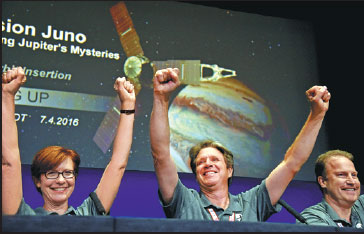Solar-powered visitor begins orbiting Jupiter
Soaring over Jupiter's poles, a NASA spacecraft arrived at the solar system's largest planet on a mission to peek behind the cloud tops.
The final leg of the five-year voyage ended on Monday when the solar-powered Juno spacecraft fired its main rocket engine and gracefully slipped into orbit around Jupiter. NASA mission controllers celebrated when Juno sent back radio signals confirming it had reached its destination.
"We're there. We're in orbit. We conquered Jupiter," Juno chief scientist Scott Bolton said during a post-mission briefing.
In the weeks leading up to the encounter, Juno snapped pictures of the giant planet and its four inner moons. Scientists were surprised to see Jupiter's second-largest moon, Callisto, appearing dimmer than expected.
The spacecraft's camera and other instruments were switched off for arrival, so there weren't any pictures at that key moment. Scientists have promised close-up views of the planet when Juno skims the cloud tops during the 20-month, $1.1 billion mission managed by NASA's Jet Propulsion Laboratory in Pasadena, California.
The fifth planet from the sun and the heftiest in the solar system, Jupiter is known as a gas giant - a ball of hydrogen and helium - unlike rocky Earth and Mars.
With its billowy clouds and colorful stripes, Jupiter is an extreme world that likely formed first, shortly after the sun. Unlocking its history may hold clues to understanding how Earth and the rest of the solar system developed.
Named after Jupiter's cloud-piercing wife in Roman mythology, Juno is only the second mission designed to spend time at Jupiter.
Galileo, launched in 1989, circled Jupiter for nearly a decade, beaming back splendid views of the planet and its numerous moons.
|
NASA mission leaders Diane Brown (left), Juno program executive, and Scott Bolton (center), Juno chief scientist, celebrate after the spacecraft entered Jupiter's orbit. Robyn Beck / Afp |



















